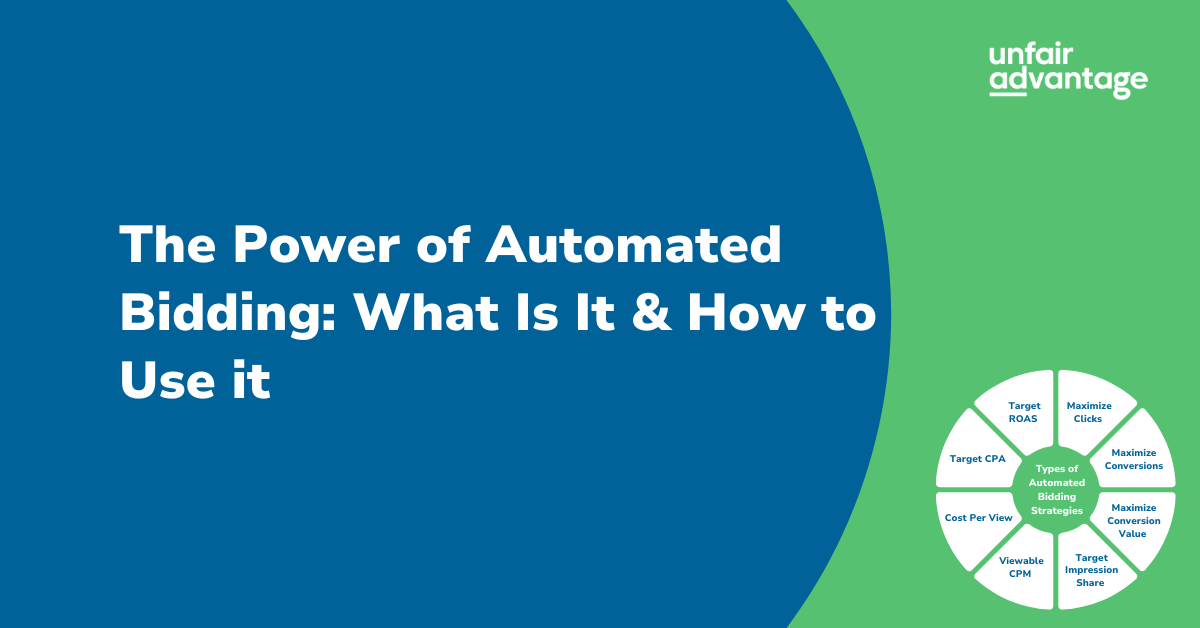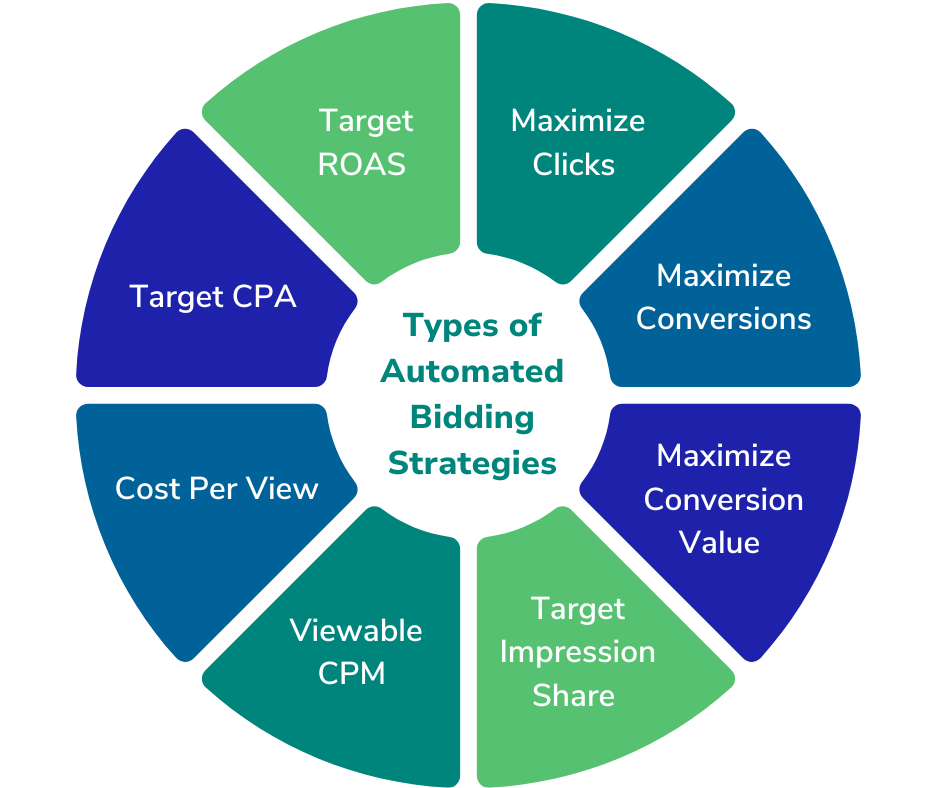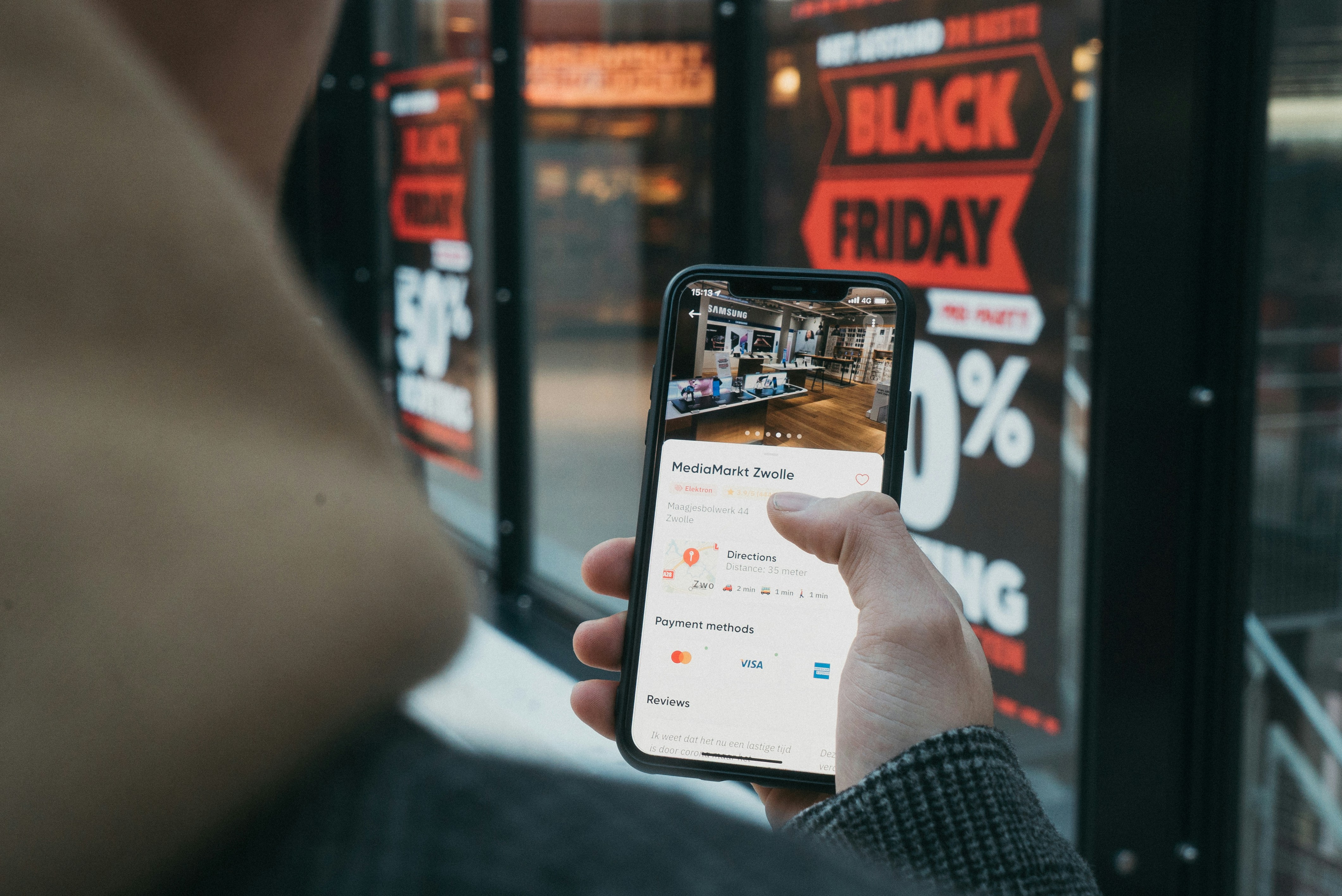
The Power of Automated Bidding: What Is It & How to Use it
Automated bidding can be a game-changer for small to medium-sized businesses looking to optimize their pay-per-click (PPC) campaigns within Google Ads. Leveraging advanced machine learning, automated bidding can help you achieve better results with less manual effort. For one of our e-commerce clients, we leveraged automated bidding to decrease spend -14% while increasing revenue +17%, which led to a +36% increase in ROAS QoQ. How did we do it? Let’s dive into the details!
What is Automated Bidding?
Automated bidding is a strategy where algorithms adjust your bids in real time to help you achieve your campaign goals. This approach considers various signals, such as user device, location, and time of day, to make precise adjustments.
As AI continues to advance, automated bidding strategies are no longer optional but essential. The balance of control between advertisers and platforms has shifted as Google moves away from manual bidding. According to Google, optimizing bids at granular levels like keyword, device, or location is inefficient. Instead, they advocate for using machine learning and algorithms to set bids automatically, allowing advertisers to focus on higher-level strategies. This approach aims to achieve desired goals more efficiently by leveraging the power of AI.
Benefits of Automated Bidding
Automated bidding offers several advantages that can significantly improve your PPC campaign performance. It can eliminate the need for constant manual adjustments, which saves time and allows you to focus on other important aspects of your business. By analyzing a vast amount of data in real time, automated bidding algorithms can make more informed decisions about bid adjustments. This leads to better optimization of your ad spend, ensuring that your budget is used effectively.
Automated bidding strategies are designed to help you achieve specific campaign goals, whether it’s maximizing conversions, clicks, or impressions. The algorithms can adjust bids based on various signals, such as device, location, and time of day, to improve your ad performance.
While automated bidding is a great tool to increase your ROI, it isn’t as simple as flipping a switch. It’s important to consider your specific account goal in order to pick the right strategy for your business.
Types of Automated Bidding Strategies
There are eight different automated bidding strategies to choose from depending on the desired outcome. Each strategy will automatically set your bids:

- Target CPA – The user sets a target Cost-Per-Acquisition (CPA) that the algorithm will work towards while capturing as many conversions to stay more or less around the desired target. If you are using tCPA at the portfolio level you have the option of setting min and max CPC bids.
- Target ROAS – Similar to target CPA, but instead, the user sets a target Return on Ad Spend (ROAS) that the algorithm will optimize towards
- Maximize Clicks – Within your set budget, the system will work to capture as many clicks as possible, whether or not they could result in a conversion. You are able to set a maximum CPC bid limit to keep CPCs low, as Google will spend the full daily budget with this strategy.
- Maximize Conversions – Similar to Maximize Clicks, except the system will work to capture as many conversions as possible, but it can come at the cost of drastically increased CPAs. You can set a target CPA to limit the negative impact on CPA. It’s important that these campaigns have their own budgets vs a shared budget.
- Maximize Conversion Value – Also similar to Maximize Clicks and Maximize Conversions, except it tries to capture as much revenue regardless of the efficiency as long as it remains within the set budget. You can choose to set a target ROAS to help inform bidding.
- Target Impression Share – The system optimizes to show your ad at the absolute top of the page, on the top of the page, or anywhere within a Google search result. (this bid strategy is only available on search networks)
- Viewable CPM – This strategy is only available for Display and is the cost per thousand viewable impressions. This strategy allows you to bid for impressions and can be useful for branding-focused campaigns.
- Cost Per View – CPV is only available on video ads. This strategy allows you to set a campaign-level max bid you are willing to pay for the view. Google defines a view as having watched 30 seconds of your video (or the duration if it is shorter) or an interaction with your ad.
Enhanced Cost-Per-Click (eCPC) is often seen as a form of automated bidding but doesn’t fit Google’s strict definition because it allows for several manual adjustments by the user.
Each automated bidding strategy leverages the historical performance data of an account or campaign, typically from the past 14 to 30 days. This data is used to adjust bids and create a user profile likely to achieve the desired outcomes, enhancing the accuracy and efficiency of the bidding process.
While opting into automated bidding strategies can help save you time and improve performance, at Unfair Advantage, we do not believe it is a “set it and forget it” approach to PPC. No matter the bid strategy, we always recommend regularly checking performance and optimizing goals based on campaign performance.
How to Choose the Right Strategy
Each advertising account is unique, and what works for one may not work for another. However, most accounts share a common goal: efficiently growing lead or revenue volume. Target CPA (tCPA) and Target ROAS (tROAS) are popular because they aim to achieve this goal by setting bids automatically to reach a specified efficiency target.
For tCPA and tROAS to work effectively, the campaign’s budget needs to be sufficient to allow the algorithms to test various auctions and adjust bids throughout the day. These strategies focus on reaching the target CPA or ROAS without considering the individual bid costs. Instead, they adjust bids based on the likelihood of a user converting, ensuring that the most promising prospects are captured.
Other strategies, like Maximize Clicks, Target Impression Share, vCPM, and CPV, can operate within any budget constraints. However, these strategies often prioritize volume over efficiency, potentially leading to higher CPCs, CPAs, and lower ROAS. Therefore, while they ensure maximum ad exposure, they might not always be the most cost-effective option.
Historical performance also plays a crucial role in choosing the right strategy. Although Google no longer requires a specific conversion threshold to use tCPA or tROAS, it’s recommended to have at least 15 conversions in the past 30 days. More data allows the algorithms to make better-informed bidding decisions. For low-volume campaigns, starting with Maximize Conversions or Maximize Conversion Value strategies can help gather the necessary data before transitioning to a more efficient bidding strategy.
Another consideration is the user action that the algorithms should optimize towards. For e-commerce, this is typically a purchase, while for lead generation, it’s form submissions. The algorithms optimize for these primary conversion actions, building user profiles around those who complete the desired actions. If there are secondary conversion actions, they need to be specified to ensure the system optimizes for them as well.
It’s essential to test different strategies on a small scale before rolling them out across your entire account. This allows you to review performance and make informed decisions about which strategies are best suited for your campaigns.
When approaching automated bidding with our client RSMeans, a leading construction cost data company, we conducted an A/B test within Google Ads to compare manual bidding with the Maximize Conversion Value bid strategy. Our goal was to achieve higher revenue with a more efficient ROAS. This experiment was carried out over a two-month period to ensure statistical significance and confirm that switching to automated bidding would enhance account performance. The results of this experiment are illustrated in the following chart:

As spend remained stable across both arms of the experiment, campaign revenue from max conversion value increased +178% compared to manual bidding. Additionally, as spend remained stable, max conversion value led to a +145% increase in ROAS.
After seeing such success with the max conversion value bid strategy, we updated campaigns to max conversion value bid strategy. The chart below shows performance improvements quarter-over-quarter (QoQ) following implementation.

Spend decreased -14%, however, revenue increased +17%, which led to a +36% increase in ROAS QoQ.
While automated bidding helped achieve these results, it’s important to remember that it takes human touch to maximize your results. With the time saved utilizing the max conversion value bid strategy, we were able to run deeper analyses to optimize the account with tailored ad copy, query matching, and geo-targeting, leading to improved account performance.
Going Forward
Automated bidding can significantly enhance the performance of your PPC campaigns by making real-time adjustments based on machine learning. Whether you’re aiming to increase conversions, drive more traffic, or boost brand awareness, there’s an automated bidding strategy that fits your needs.
If you need assistance with your PPC strategy, our paid media experts are ready to help you maximize your ad spend and achieve your marketing goals. Contact our team today!
Houston PPC Services, San Antonio PPC Services, Waco PPC Services, Austin PPC Services, Forth Worth PPC Services, Dallas PPC Services
